Holmes Institute Taxation Law Individual Assignment T2 2019
VerifiedAdded on 2022/10/16
|10
|2820
|424
Homework Assignment
AI Summary
This taxation assignment analyzes the tax liabilities of two scenarios: Jasmine, an Australian resident, and John, a manufacturing business owner. Jasmine's case examines the tax implications of selling a main residence, a car, business equipment, goodwill, furniture, and paintings. The analysis determines the applicability of capital gains tax based on asset types, purchase dates, and personal use. John's scenario focuses on the cost basis and depreciation of a CNC machine, imported from Germany, considering installation costs, and additional components. The assignment calculates the total cost of the machine, the starting point for depreciation, and the relevant tax implications, demonstrating an understanding of Australian taxation law, capital gains tax, and depreciation rules. The assignment also delves into concessions available for small businesses and the concept of goodwill as a taxable asset.
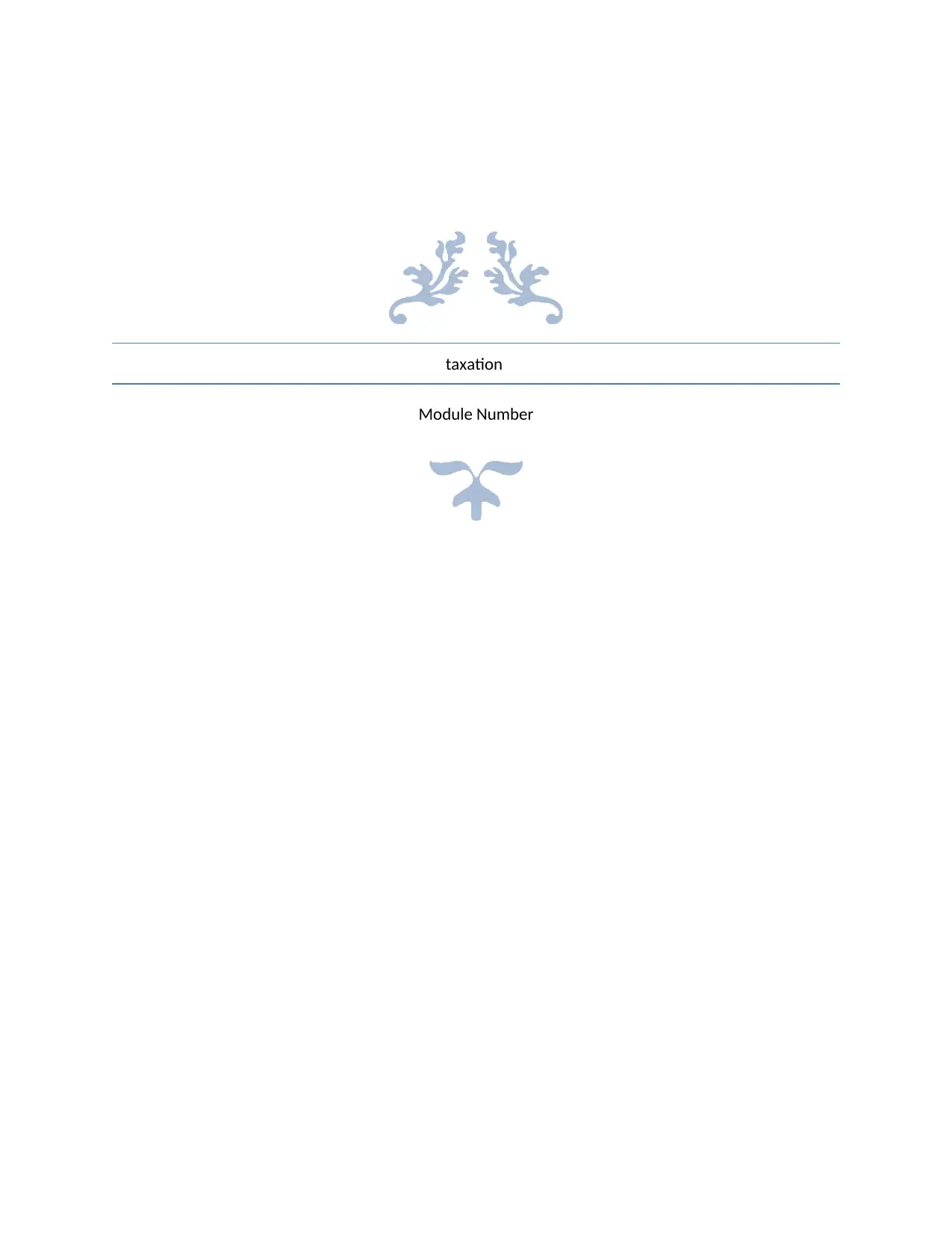
taxation
Module Number
Module Number
Paraphrase This Document
Need a fresh take? Get an instant paraphrase of this document with our AI Paraphraser
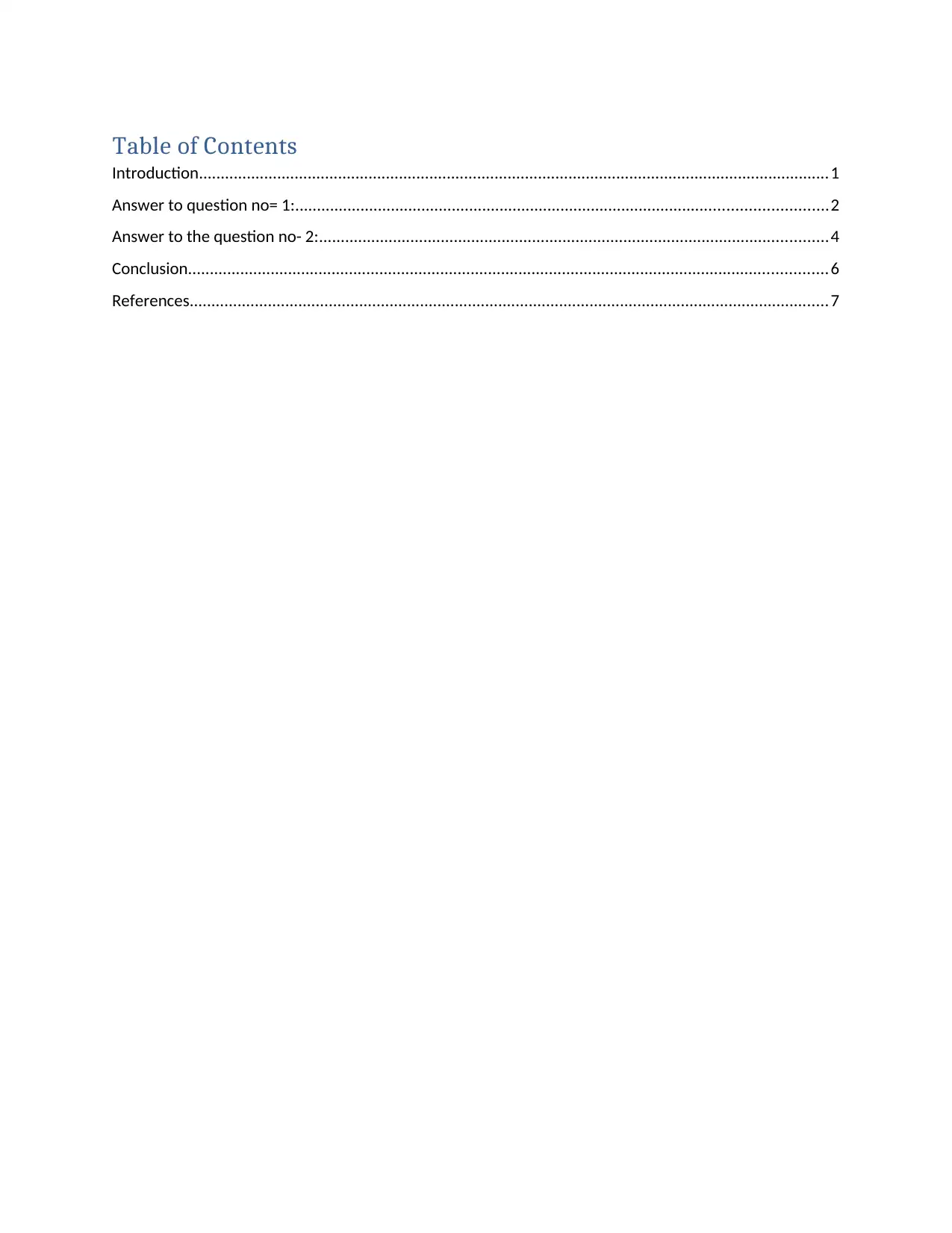
Table of Contents
Introduction.................................................................................................................................................1
Answer to question no= 1:..........................................................................................................................2
Answer to the question no- 2:.....................................................................................................................4
Conclusion...................................................................................................................................................6
References...................................................................................................................................................7
Introduction.................................................................................................................................................1
Answer to question no= 1:..........................................................................................................................2
Answer to the question no- 2:.....................................................................................................................4
Conclusion...................................................................................................................................................6
References...................................................................................................................................................7
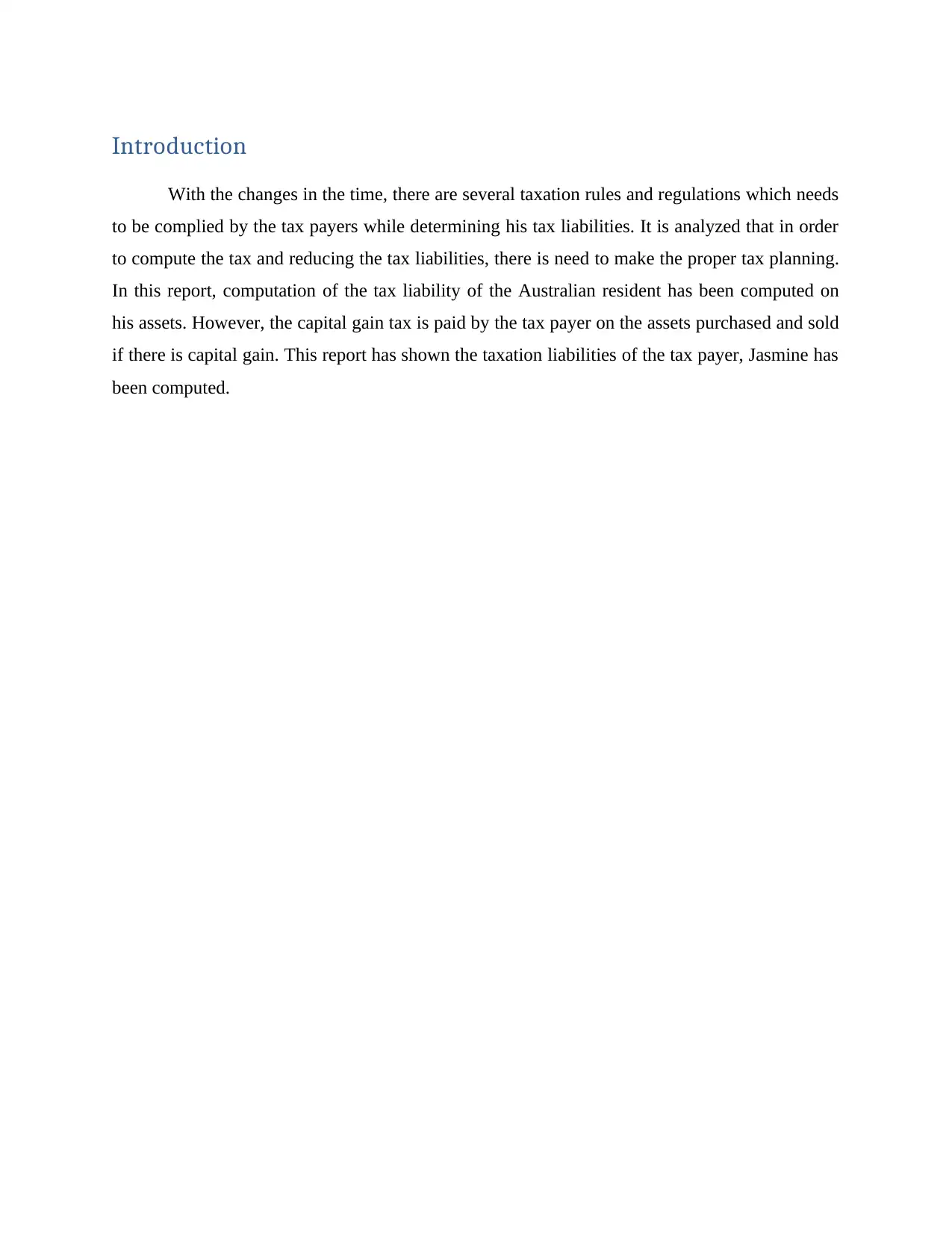
Introduction
With the changes in the time, there are several taxation rules and regulations which needs
to be complied by the tax payers while determining his tax liabilities. It is analyzed that in order
to compute the tax and reducing the tax liabilities, there is need to make the proper tax planning.
In this report, computation of the tax liability of the Australian resident has been computed on
his assets. However, the capital gain tax is paid by the tax payer on the assets purchased and sold
if there is capital gain. This report has shown the taxation liabilities of the tax payer, Jasmine has
been computed.
With the changes in the time, there are several taxation rules and regulations which needs
to be complied by the tax payers while determining his tax liabilities. It is analyzed that in order
to compute the tax and reducing the tax liabilities, there is need to make the proper tax planning.
In this report, computation of the tax liability of the Australian resident has been computed on
his assets. However, the capital gain tax is paid by the tax payer on the assets purchased and sold
if there is capital gain. This report has shown the taxation liabilities of the tax payer, Jasmine has
been computed.
⊘ This is a preview!⊘
Do you want full access?
Subscribe today to unlock all pages.

Trusted by 1+ million students worldwide
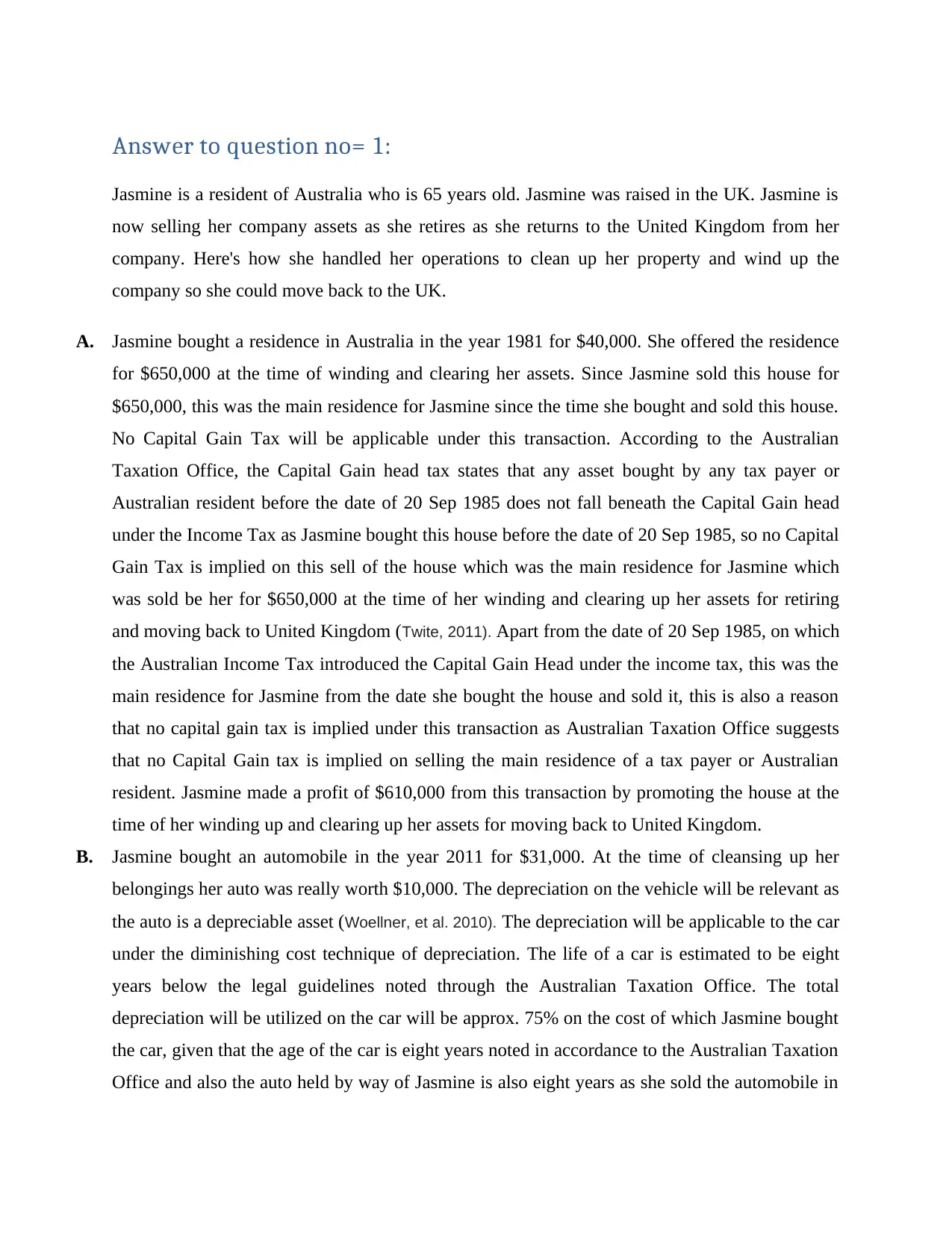
Answer to question no= 1:
Jasmine is a resident of Australia who is 65 years old. Jasmine was raised in the UK. Jasmine is
now selling her company assets as she retires as she returns to the United Kingdom from her
company. Here's how she handled her operations to clean up her property and wind up the
company so she could move back to the UK.
A. Jasmine bought a residence in Australia in the year 1981 for $40,000. She offered the residence
for $650,000 at the time of winding and clearing her assets. Since Jasmine sold this house for
$650,000, this was the main residence for Jasmine since the time she bought and sold this house.
No Capital Gain Tax will be applicable under this transaction. According to the Australian
Taxation Office, the Capital Gain head tax states that any asset bought by any tax payer or
Australian resident before the date of 20 Sep 1985 does not fall beneath the Capital Gain head
under the Income Tax as Jasmine bought this house before the date of 20 Sep 1985, so no Capital
Gain Tax is implied on this sell of the house which was the main residence for Jasmine which
was sold be her for $650,000 at the time of her winding and clearing up her assets for retiring
and moving back to United Kingdom (Twite, 2011). Apart from the date of 20 Sep 1985, on which
the Australian Income Tax introduced the Capital Gain Head under the income tax, this was the
main residence for Jasmine from the date she bought the house and sold it, this is also a reason
that no capital gain tax is implied under this transaction as Australian Taxation Office suggests
that no Capital Gain tax is implied on selling the main residence of a tax payer or Australian
resident. Jasmine made a profit of $610,000 from this transaction by promoting the house at the
time of her winding up and clearing up her assets for moving back to United Kingdom.
B. Jasmine bought an automobile in the year 2011 for $31,000. At the time of cleansing up her
belongings her auto was really worth $10,000. The depreciation on the vehicle will be relevant as
the auto is a depreciable asset (Woellner, et al. 2010). The depreciation will be applicable to the car
under the diminishing cost technique of depreciation. The life of a car is estimated to be eight
years below the legal guidelines noted through the Australian Taxation Office. The total
depreciation will be utilized on the car will be approx. 75% on the cost of which Jasmine bought
the car, given that the age of the car is eight years noted in accordance to the Australian Taxation
Office and also the auto held by way of Jasmine is also eight years as she sold the automobile in
Jasmine is a resident of Australia who is 65 years old. Jasmine was raised in the UK. Jasmine is
now selling her company assets as she retires as she returns to the United Kingdom from her
company. Here's how she handled her operations to clean up her property and wind up the
company so she could move back to the UK.
A. Jasmine bought a residence in Australia in the year 1981 for $40,000. She offered the residence
for $650,000 at the time of winding and clearing her assets. Since Jasmine sold this house for
$650,000, this was the main residence for Jasmine since the time she bought and sold this house.
No Capital Gain Tax will be applicable under this transaction. According to the Australian
Taxation Office, the Capital Gain head tax states that any asset bought by any tax payer or
Australian resident before the date of 20 Sep 1985 does not fall beneath the Capital Gain head
under the Income Tax as Jasmine bought this house before the date of 20 Sep 1985, so no Capital
Gain Tax is implied on this sell of the house which was the main residence for Jasmine which
was sold be her for $650,000 at the time of her winding and clearing up her assets for retiring
and moving back to United Kingdom (Twite, 2011). Apart from the date of 20 Sep 1985, on which
the Australian Income Tax introduced the Capital Gain Head under the income tax, this was the
main residence for Jasmine from the date she bought the house and sold it, this is also a reason
that no capital gain tax is implied under this transaction as Australian Taxation Office suggests
that no Capital Gain tax is implied on selling the main residence of a tax payer or Australian
resident. Jasmine made a profit of $610,000 from this transaction by promoting the house at the
time of her winding up and clearing up her assets for moving back to United Kingdom.
B. Jasmine bought an automobile in the year 2011 for $31,000. At the time of cleansing up her
belongings her auto was really worth $10,000. The depreciation on the vehicle will be relevant as
the auto is a depreciable asset (Woellner, et al. 2010). The depreciation will be applicable to the car
under the diminishing cost technique of depreciation. The life of a car is estimated to be eight
years below the legal guidelines noted through the Australian Taxation Office. The total
depreciation will be utilized on the car will be approx. 75% on the cost of which Jasmine bought
the car, given that the age of the car is eight years noted in accordance to the Australian Taxation
Office and also the auto held by way of Jasmine is also eight years as she sold the automobile in
Paraphrase This Document
Need a fresh take? Get an instant paraphrase of this document with our AI Paraphraser
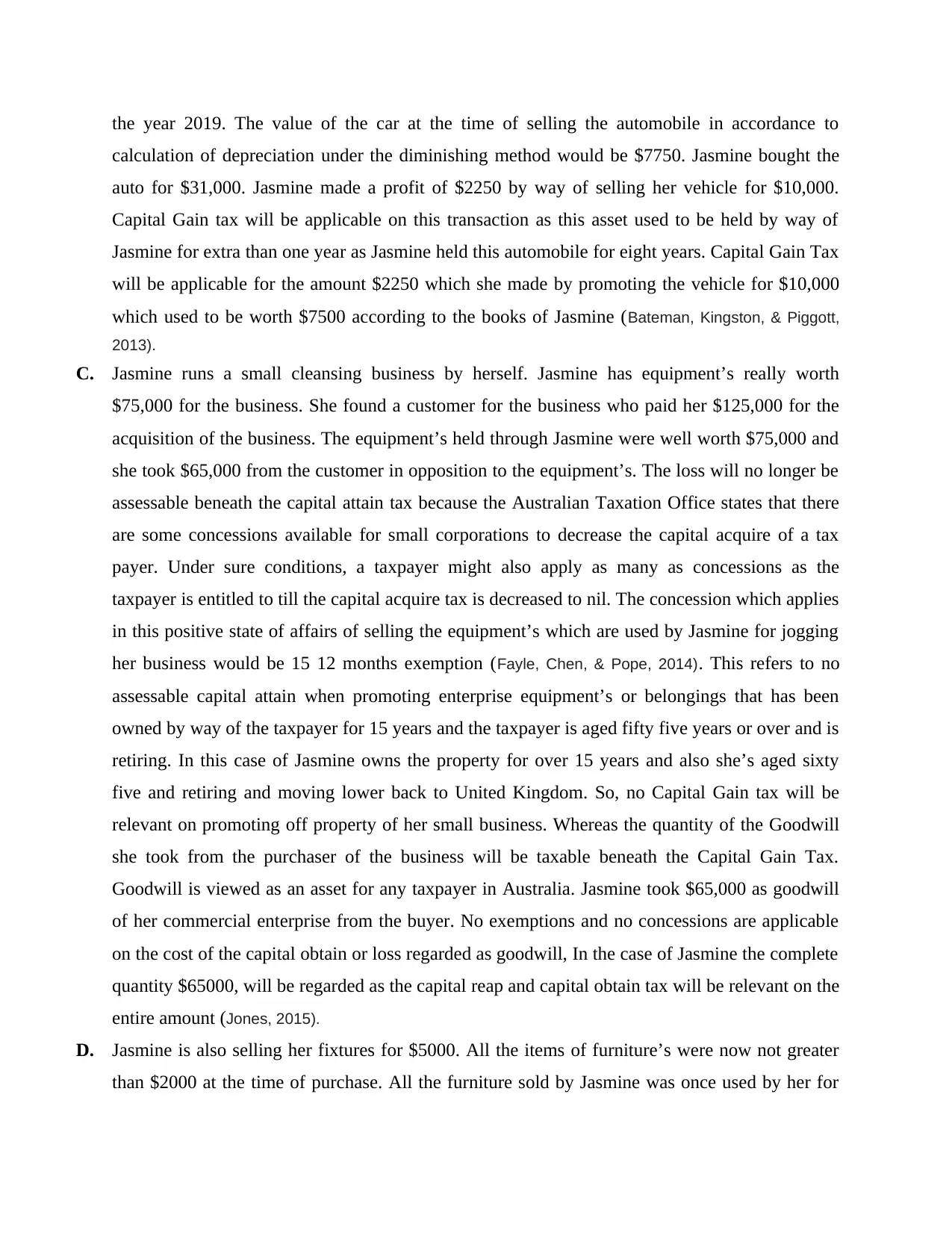
the year 2019. The value of the car at the time of selling the automobile in accordance to
calculation of depreciation under the diminishing method would be $7750. Jasmine bought the
auto for $31,000. Jasmine made a profit of $2250 by way of selling her vehicle for $10,000.
Capital Gain tax will be applicable on this transaction as this asset used to be held by way of
Jasmine for extra than one year as Jasmine held this automobile for eight years. Capital Gain Tax
will be applicable for the amount $2250 which she made by promoting the vehicle for $10,000
which used to be worth $7500 according to the books of Jasmine (Bateman, Kingston, & Piggott,
2013).
C. Jasmine runs a small cleansing business by herself. Jasmine has equipment’s really worth
$75,000 for the business. She found a customer for the business who paid her $125,000 for the
acquisition of the business. The equipment’s held through Jasmine were well worth $75,000 and
she took $65,000 from the customer in opposition to the equipment’s. The loss will no longer be
assessable beneath the capital attain tax because the Australian Taxation Office states that there
are some concessions available for small corporations to decrease the capital acquire of a tax
payer. Under sure conditions, a taxpayer might also apply as many as concessions as the
taxpayer is entitled to till the capital acquire tax is decreased to nil. The concession which applies
in this positive state of affairs of selling the equipment’s which are used by Jasmine for jogging
her business would be 15 12 months exemption (Fayle, Chen, & Pope, 2014). This refers to no
assessable capital attain when promoting enterprise equipment’s or belongings that has been
owned by way of the taxpayer for 15 years and the taxpayer is aged fifty five years or over and is
retiring. In this case of Jasmine owns the property for over 15 years and also she’s aged sixty
five and retiring and moving lower back to United Kingdom. So, no Capital Gain tax will be
relevant on promoting off property of her small business. Whereas the quantity of the Goodwill
she took from the purchaser of the business will be taxable beneath the Capital Gain Tax.
Goodwill is viewed as an asset for any taxpayer in Australia. Jasmine took $65,000 as goodwill
of her commercial enterprise from the buyer. No exemptions and no concessions are applicable
on the cost of the capital obtain or loss regarded as goodwill, In the case of Jasmine the complete
quantity $65000, will be regarded as the capital reap and capital obtain tax will be relevant on the
entire amount (Jones, 2015).
D. Jasmine is also selling her fixtures for $5000. All the items of furniture’s were now not greater
than $2000 at the time of purchase. All the furniture sold by Jasmine was once used by her for
calculation of depreciation under the diminishing method would be $7750. Jasmine bought the
auto for $31,000. Jasmine made a profit of $2250 by way of selling her vehicle for $10,000.
Capital Gain tax will be applicable on this transaction as this asset used to be held by way of
Jasmine for extra than one year as Jasmine held this automobile for eight years. Capital Gain Tax
will be applicable for the amount $2250 which she made by promoting the vehicle for $10,000
which used to be worth $7500 according to the books of Jasmine (Bateman, Kingston, & Piggott,
2013).
C. Jasmine runs a small cleansing business by herself. Jasmine has equipment’s really worth
$75,000 for the business. She found a customer for the business who paid her $125,000 for the
acquisition of the business. The equipment’s held through Jasmine were well worth $75,000 and
she took $65,000 from the customer in opposition to the equipment’s. The loss will no longer be
assessable beneath the capital attain tax because the Australian Taxation Office states that there
are some concessions available for small corporations to decrease the capital acquire of a tax
payer. Under sure conditions, a taxpayer might also apply as many as concessions as the
taxpayer is entitled to till the capital acquire tax is decreased to nil. The concession which applies
in this positive state of affairs of selling the equipment’s which are used by Jasmine for jogging
her business would be 15 12 months exemption (Fayle, Chen, & Pope, 2014). This refers to no
assessable capital attain when promoting enterprise equipment’s or belongings that has been
owned by way of the taxpayer for 15 years and the taxpayer is aged fifty five years or over and is
retiring. In this case of Jasmine owns the property for over 15 years and also she’s aged sixty
five and retiring and moving lower back to United Kingdom. So, no Capital Gain tax will be
relevant on promoting off property of her small business. Whereas the quantity of the Goodwill
she took from the purchaser of the business will be taxable beneath the Capital Gain Tax.
Goodwill is viewed as an asset for any taxpayer in Australia. Jasmine took $65,000 as goodwill
of her commercial enterprise from the buyer. No exemptions and no concessions are applicable
on the cost of the capital obtain or loss regarded as goodwill, In the case of Jasmine the complete
quantity $65000, will be regarded as the capital reap and capital obtain tax will be relevant on the
entire amount (Jones, 2015).
D. Jasmine is also selling her fixtures for $5000. All the items of furniture’s were now not greater
than $2000 at the time of purchase. All the furniture sold by Jasmine was once used by her for
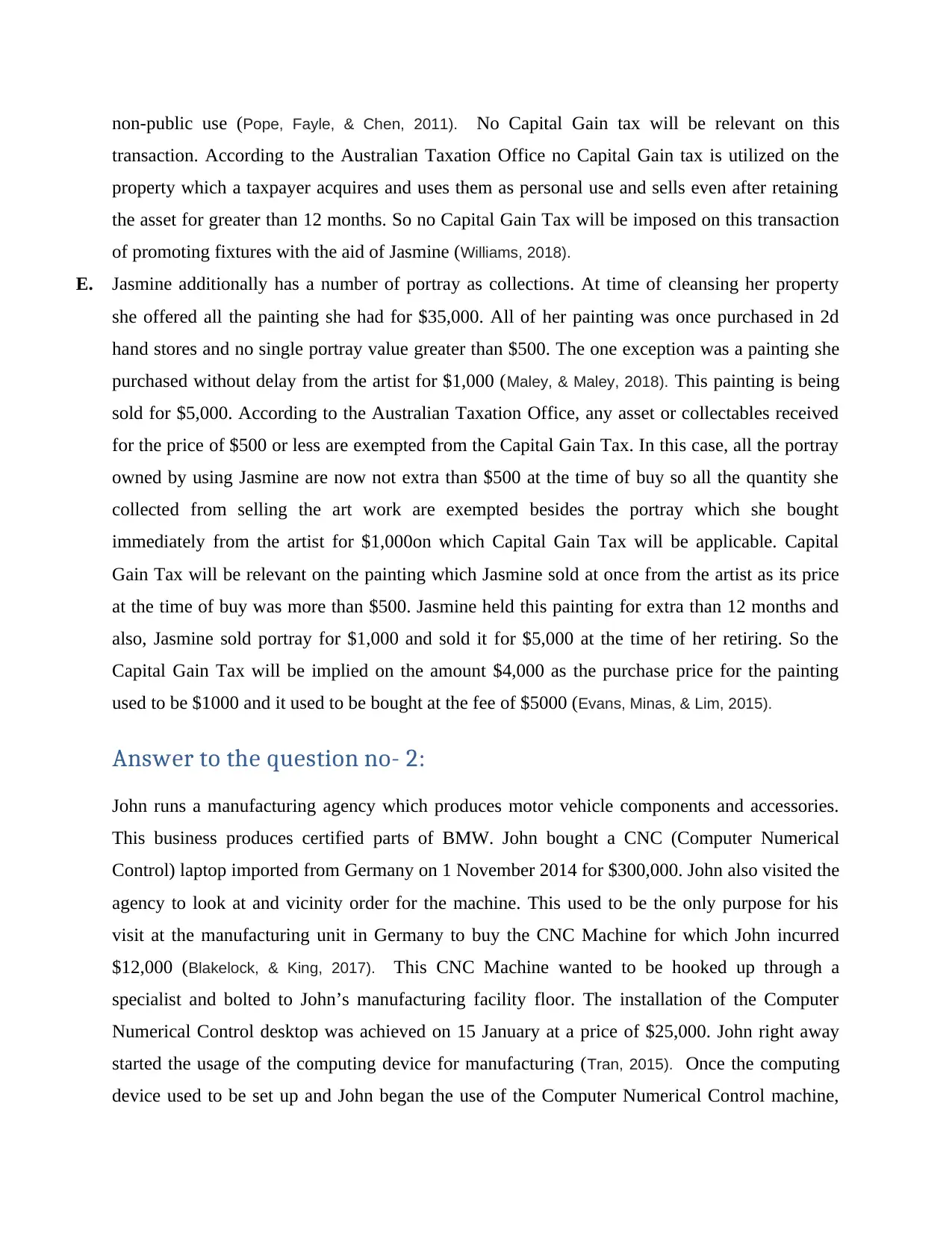
non-public use (Pope, Fayle, & Chen, 2011). No Capital Gain tax will be relevant on this
transaction. According to the Australian Taxation Office no Capital Gain tax is utilized on the
property which a taxpayer acquires and uses them as personal use and sells even after retaining
the asset for greater than 12 months. So no Capital Gain Tax will be imposed on this transaction
of promoting fixtures with the aid of Jasmine (Williams, 2018).
E. Jasmine additionally has a number of portray as collections. At time of cleansing her property
she offered all the painting she had for $35,000. All of her painting was once purchased in 2d
hand stores and no single portray value greater than $500. The one exception was a painting she
purchased without delay from the artist for $1,000 (Maley, & Maley, 2018). This painting is being
sold for $5,000. According to the Australian Taxation Office, any asset or collectables received
for the price of $500 or less are exempted from the Capital Gain Tax. In this case, all the portray
owned by using Jasmine are now not extra than $500 at the time of buy so all the quantity she
collected from selling the art work are exempted besides the portray which she bought
immediately from the artist for $1,000on which Capital Gain Tax will be applicable. Capital
Gain Tax will be relevant on the painting which Jasmine sold at once from the artist as its price
at the time of buy was more than $500. Jasmine held this painting for extra than 12 months and
also, Jasmine sold portray for $1,000 and sold it for $5,000 at the time of her retiring. So the
Capital Gain Tax will be implied on the amount $4,000 as the purchase price for the painting
used to be $1000 and it used to be bought at the fee of $5000 (Evans, Minas, & Lim, 2015).
Answer to the question no- 2:
John runs a manufacturing agency which produces motor vehicle components and accessories.
This business produces certified parts of BMW. John bought a CNC (Computer Numerical
Control) laptop imported from Germany on 1 November 2014 for $300,000. John also visited the
agency to look at and vicinity order for the machine. This used to be the only purpose for his
visit at the manufacturing unit in Germany to buy the CNC Machine for which John incurred
$12,000 (Blakelock, & King, 2017). This CNC Machine wanted to be hooked up through a
specialist and bolted to John’s manufacturing facility floor. The installation of the Computer
Numerical Control desktop was achieved on 15 January at a price of $25,000. John right away
started the usage of the computing device for manufacturing (Tran, 2015). Once the computing
device used to be set up and John began the use of the Computer Numerical Control machine,
transaction. According to the Australian Taxation Office no Capital Gain tax is utilized on the
property which a taxpayer acquires and uses them as personal use and sells even after retaining
the asset for greater than 12 months. So no Capital Gain Tax will be imposed on this transaction
of promoting fixtures with the aid of Jasmine (Williams, 2018).
E. Jasmine additionally has a number of portray as collections. At time of cleansing her property
she offered all the painting she had for $35,000. All of her painting was once purchased in 2d
hand stores and no single portray value greater than $500. The one exception was a painting she
purchased without delay from the artist for $1,000 (Maley, & Maley, 2018). This painting is being
sold for $5,000. According to the Australian Taxation Office, any asset or collectables received
for the price of $500 or less are exempted from the Capital Gain Tax. In this case, all the portray
owned by using Jasmine are now not extra than $500 at the time of buy so all the quantity she
collected from selling the art work are exempted besides the portray which she bought
immediately from the artist for $1,000on which Capital Gain Tax will be applicable. Capital
Gain Tax will be relevant on the painting which Jasmine sold at once from the artist as its price
at the time of buy was more than $500. Jasmine held this painting for extra than 12 months and
also, Jasmine sold portray for $1,000 and sold it for $5,000 at the time of her retiring. So the
Capital Gain Tax will be implied on the amount $4,000 as the purchase price for the painting
used to be $1000 and it used to be bought at the fee of $5000 (Evans, Minas, & Lim, 2015).
Answer to the question no- 2:
John runs a manufacturing agency which produces motor vehicle components and accessories.
This business produces certified parts of BMW. John bought a CNC (Computer Numerical
Control) laptop imported from Germany on 1 November 2014 for $300,000. John also visited the
agency to look at and vicinity order for the machine. This used to be the only purpose for his
visit at the manufacturing unit in Germany to buy the CNC Machine for which John incurred
$12,000 (Blakelock, & King, 2017). This CNC Machine wanted to be hooked up through a
specialist and bolted to John’s manufacturing facility floor. The installation of the Computer
Numerical Control desktop was achieved on 15 January at a price of $25,000. John right away
started the usage of the computing device for manufacturing (Tran, 2015). Once the computing
device used to be set up and John began the use of the Computer Numerical Control machine,
⊘ This is a preview!⊘
Do you want full access?
Subscribe today to unlock all pages.

Trusted by 1+ million students worldwide
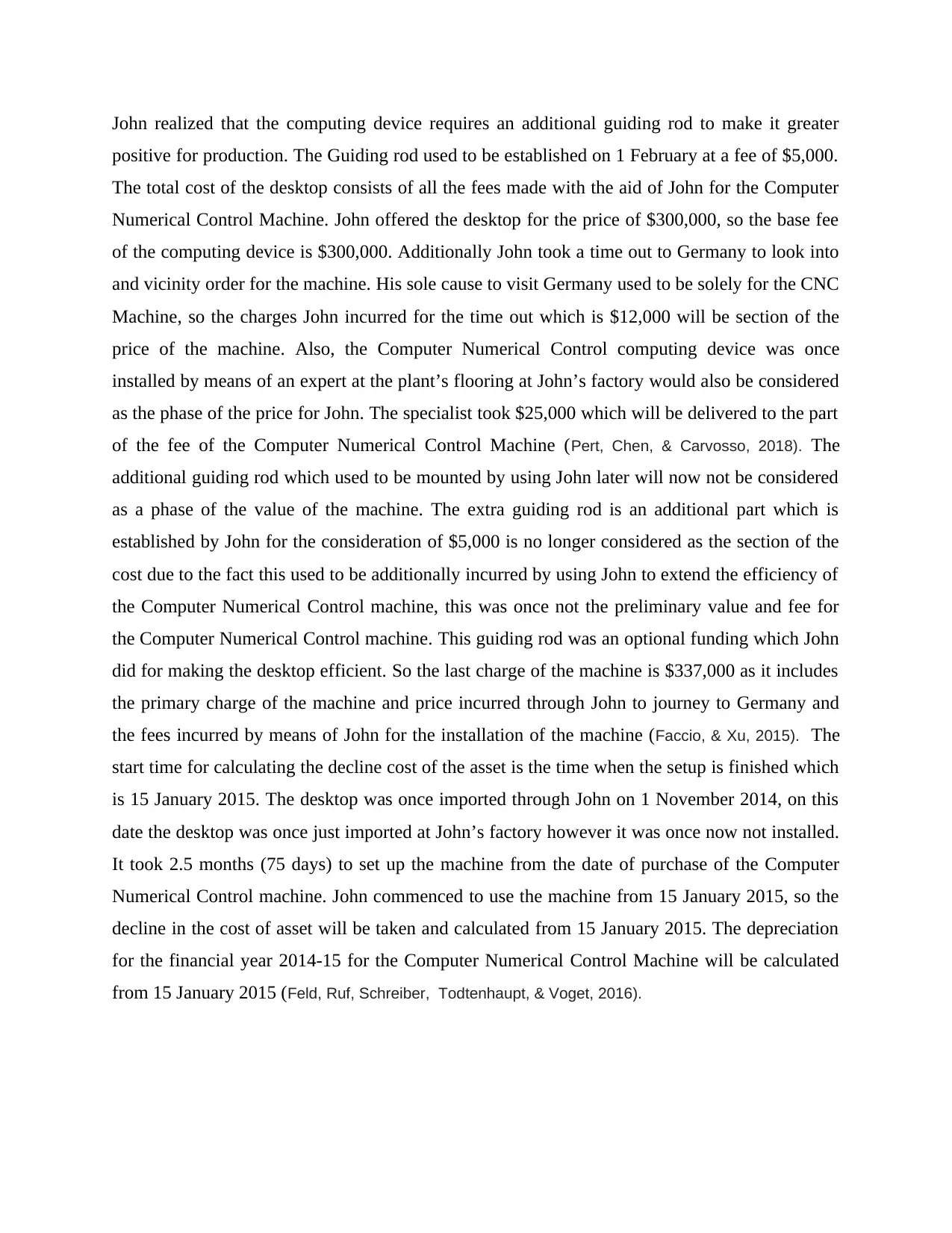
John realized that the computing device requires an additional guiding rod to make it greater
positive for production. The Guiding rod used to be established on 1 February at a fee of $5,000.
The total cost of the desktop consists of all the fees made with the aid of John for the Computer
Numerical Control Machine. John offered the desktop for the price of $300,000, so the base fee
of the computing device is $300,000. Additionally John took a time out to Germany to look into
and vicinity order for the machine. His sole cause to visit Germany used to be solely for the CNC
Machine, so the charges John incurred for the time out which is $12,000 will be section of the
price of the machine. Also, the Computer Numerical Control computing device was once
installed by means of an expert at the plant’s flooring at John’s factory would also be considered
as the phase of the price for John. The specialist took $25,000 which will be delivered to the part
of the fee of the Computer Numerical Control Machine (Pert, Chen, & Carvosso, 2018). The
additional guiding rod which used to be mounted by using John later will now not be considered
as a phase of the value of the machine. The extra guiding rod is an additional part which is
established by John for the consideration of $5,000 is no longer considered as the section of the
cost due to the fact this used to be additionally incurred by using John to extend the efficiency of
the Computer Numerical Control machine, this was once not the preliminary value and fee for
the Computer Numerical Control machine. This guiding rod was an optional funding which John
did for making the desktop efficient. So the last charge of the machine is $337,000 as it includes
the primary charge of the machine and price incurred through John to journey to Germany and
the fees incurred by means of John for the installation of the machine (Faccio, & Xu, 2015). The
start time for calculating the decline cost of the asset is the time when the setup is finished which
is 15 January 2015. The desktop was once imported through John on 1 November 2014, on this
date the desktop was once just imported at John’s factory however it was once now not installed.
It took 2.5 months (75 days) to set up the machine from the date of purchase of the Computer
Numerical Control machine. John commenced to use the machine from 15 January 2015, so the
decline in the cost of asset will be taken and calculated from 15 January 2015. The depreciation
for the financial year 2014-15 for the Computer Numerical Control Machine will be calculated
from 15 January 2015 (Feld, Ruf, Schreiber, Todtenhaupt, & Voget, 2016).
positive for production. The Guiding rod used to be established on 1 February at a fee of $5,000.
The total cost of the desktop consists of all the fees made with the aid of John for the Computer
Numerical Control Machine. John offered the desktop for the price of $300,000, so the base fee
of the computing device is $300,000. Additionally John took a time out to Germany to look into
and vicinity order for the machine. His sole cause to visit Germany used to be solely for the CNC
Machine, so the charges John incurred for the time out which is $12,000 will be section of the
price of the machine. Also, the Computer Numerical Control computing device was once
installed by means of an expert at the plant’s flooring at John’s factory would also be considered
as the phase of the price for John. The specialist took $25,000 which will be delivered to the part
of the fee of the Computer Numerical Control Machine (Pert, Chen, & Carvosso, 2018). The
additional guiding rod which used to be mounted by using John later will now not be considered
as a phase of the value of the machine. The extra guiding rod is an additional part which is
established by John for the consideration of $5,000 is no longer considered as the section of the
cost due to the fact this used to be additionally incurred by using John to extend the efficiency of
the Computer Numerical Control machine, this was once not the preliminary value and fee for
the Computer Numerical Control machine. This guiding rod was an optional funding which John
did for making the desktop efficient. So the last charge of the machine is $337,000 as it includes
the primary charge of the machine and price incurred through John to journey to Germany and
the fees incurred by means of John for the installation of the machine (Faccio, & Xu, 2015). The
start time for calculating the decline cost of the asset is the time when the setup is finished which
is 15 January 2015. The desktop was once imported through John on 1 November 2014, on this
date the desktop was once just imported at John’s factory however it was once now not installed.
It took 2.5 months (75 days) to set up the machine from the date of purchase of the Computer
Numerical Control machine. John commenced to use the machine from 15 January 2015, so the
decline in the cost of asset will be taken and calculated from 15 January 2015. The depreciation
for the financial year 2014-15 for the Computer Numerical Control Machine will be calculated
from 15 January 2015 (Feld, Ruf, Schreiber, Todtenhaupt, & Voget, 2016).
Paraphrase This Document
Need a fresh take? Get an instant paraphrase of this document with our AI Paraphraser
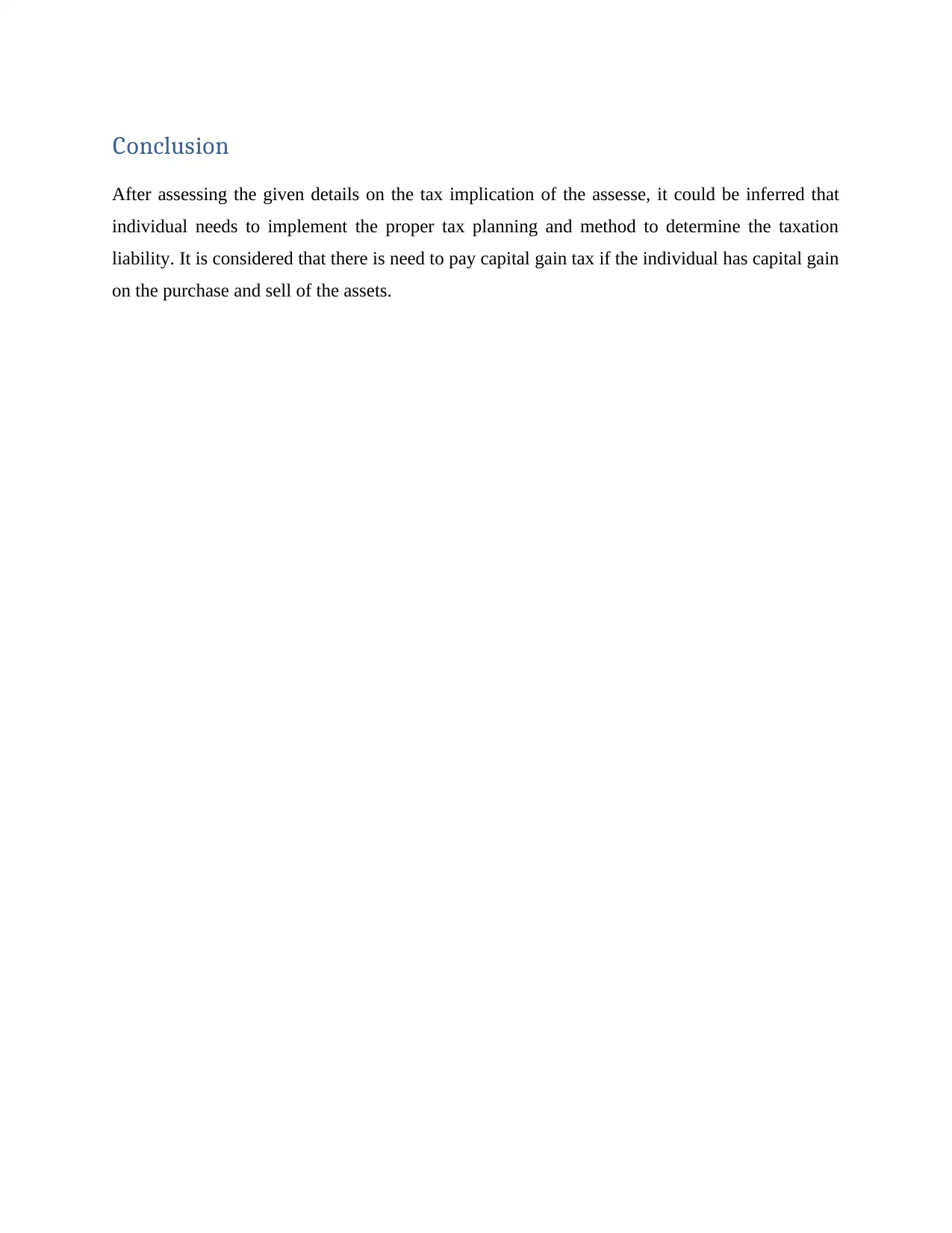
Conclusion
After assessing the given details on the tax implication of the assesse, it could be inferred that
individual needs to implement the proper tax planning and method to determine the taxation
liability. It is considered that there is need to pay capital gain tax if the individual has capital gain
on the purchase and sell of the assets.
After assessing the given details on the tax implication of the assesse, it could be inferred that
individual needs to implement the proper tax planning and method to determine the taxation
liability. It is considered that there is need to pay capital gain tax if the individual has capital gain
on the purchase and sell of the assets.
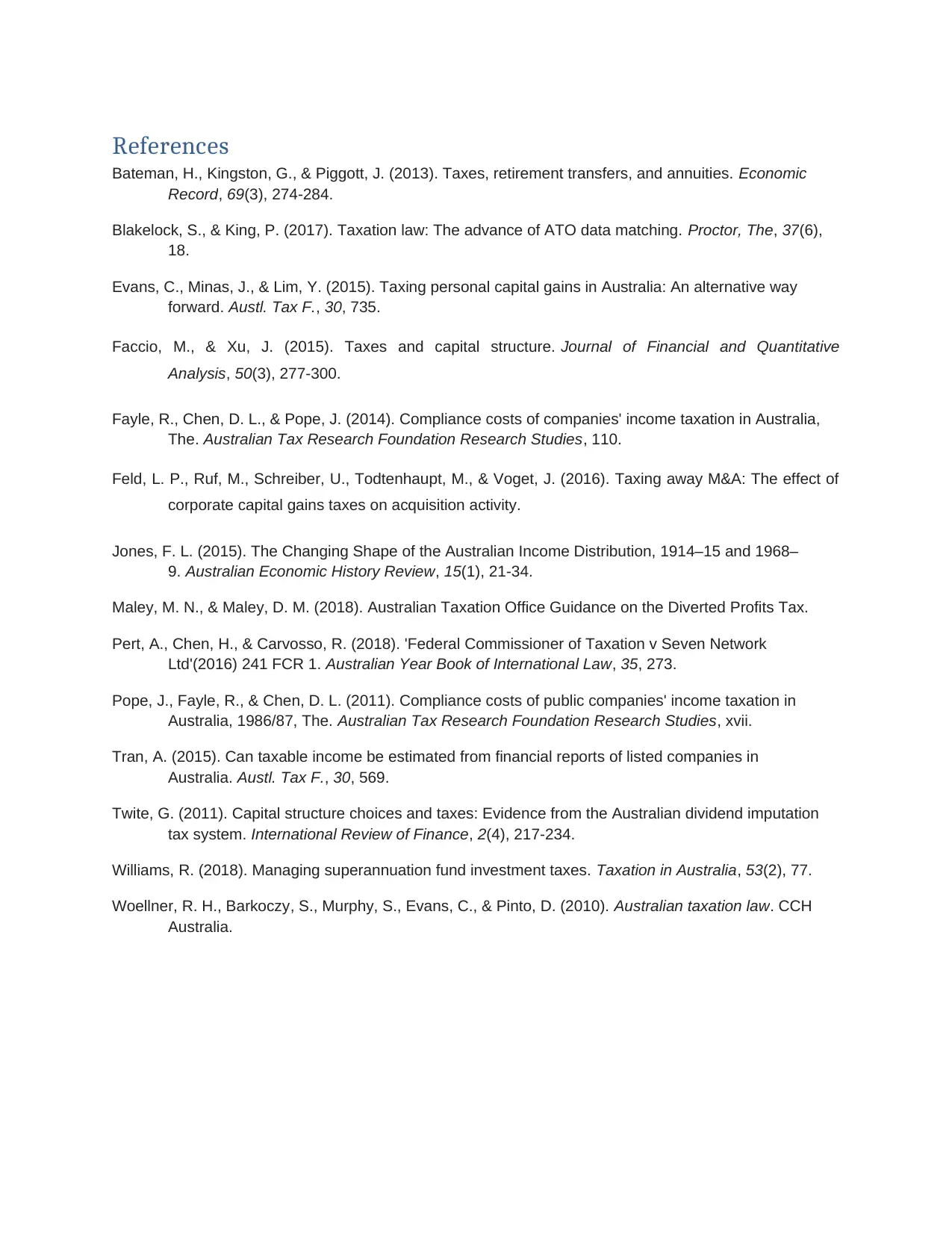
References
Bateman, H., Kingston, G., & Piggott, J. (2013). Taxes, retirement transfers, and annuities. Economic
Record, 69(3), 274-284.
Blakelock, S., & King, P. (2017). Taxation law: The advance of ATO data matching. Proctor, The, 37(6),
18.
Evans, C., Minas, J., & Lim, Y. (2015). Taxing personal capital gains in Australia: An alternative way
forward. Austl. Tax F., 30, 735.
Faccio, M., & Xu, J. (2015). Taxes and capital structure. Journal of Financial and Quantitative
Analysis, 50(3), 277-300.
Fayle, R., Chen, D. L., & Pope, J. (2014). Compliance costs of companies' income taxation in Australia,
The. Australian Tax Research Foundation Research Studies, 110.
Feld, L. P., Ruf, M., Schreiber, U., Todtenhaupt, M., & Voget, J. (2016). Taxing away M&A: The effect of
corporate capital gains taxes on acquisition activity.
Jones, F. L. (2015). The Changing Shape of the Australian Income Distribution, 1914–15 and 1968–
9. Australian Economic History Review, 15(1), 21-34.
Maley, M. N., & Maley, D. M. (2018). Australian Taxation Office Guidance on the Diverted Profits Tax.
Pert, A., Chen, H., & Carvosso, R. (2018). 'Federal Commissioner of Taxation v Seven Network
Ltd'(2016) 241 FCR 1. Australian Year Book of International Law, 35, 273.
Pope, J., Fayle, R., & Chen, D. L. (2011). Compliance costs of public companies' income taxation in
Australia, 1986/87, The. Australian Tax Research Foundation Research Studies, xvii.
Tran, A. (2015). Can taxable income be estimated from financial reports of listed companies in
Australia. Austl. Tax F., 30, 569.
Twite, G. (2011). Capital structure choices and taxes: Evidence from the Australian dividend imputation
tax system. International Review of Finance, 2(4), 217-234.
Williams, R. (2018). Managing superannuation fund investment taxes. Taxation in Australia, 53(2), 77.
Woellner, R. H., Barkoczy, S., Murphy, S., Evans, C., & Pinto, D. (2010). Australian taxation law. CCH
Australia.
Bateman, H., Kingston, G., & Piggott, J. (2013). Taxes, retirement transfers, and annuities. Economic
Record, 69(3), 274-284.
Blakelock, S., & King, P. (2017). Taxation law: The advance of ATO data matching. Proctor, The, 37(6),
18.
Evans, C., Minas, J., & Lim, Y. (2015). Taxing personal capital gains in Australia: An alternative way
forward. Austl. Tax F., 30, 735.
Faccio, M., & Xu, J. (2015). Taxes and capital structure. Journal of Financial and Quantitative
Analysis, 50(3), 277-300.
Fayle, R., Chen, D. L., & Pope, J. (2014). Compliance costs of companies' income taxation in Australia,
The. Australian Tax Research Foundation Research Studies, 110.
Feld, L. P., Ruf, M., Schreiber, U., Todtenhaupt, M., & Voget, J. (2016). Taxing away M&A: The effect of
corporate capital gains taxes on acquisition activity.
Jones, F. L. (2015). The Changing Shape of the Australian Income Distribution, 1914–15 and 1968–
9. Australian Economic History Review, 15(1), 21-34.
Maley, M. N., & Maley, D. M. (2018). Australian Taxation Office Guidance on the Diverted Profits Tax.
Pert, A., Chen, H., & Carvosso, R. (2018). 'Federal Commissioner of Taxation v Seven Network
Ltd'(2016) 241 FCR 1. Australian Year Book of International Law, 35, 273.
Pope, J., Fayle, R., & Chen, D. L. (2011). Compliance costs of public companies' income taxation in
Australia, 1986/87, The. Australian Tax Research Foundation Research Studies, xvii.
Tran, A. (2015). Can taxable income be estimated from financial reports of listed companies in
Australia. Austl. Tax F., 30, 569.
Twite, G. (2011). Capital structure choices and taxes: Evidence from the Australian dividend imputation
tax system. International Review of Finance, 2(4), 217-234.
Williams, R. (2018). Managing superannuation fund investment taxes. Taxation in Australia, 53(2), 77.
Woellner, R. H., Barkoczy, S., Murphy, S., Evans, C., & Pinto, D. (2010). Australian taxation law. CCH
Australia.
⊘ This is a preview!⊘
Do you want full access?
Subscribe today to unlock all pages.

Trusted by 1+ million students worldwide

1 out of 10
Related Documents
Your All-in-One AI-Powered Toolkit for Academic Success.
+13062052269
info@desklib.com
Available 24*7 on WhatsApp / Email
![[object Object]](/_next/static/media/star-bottom.7253800d.svg)
Unlock your academic potential
Copyright © 2020–2025 A2Z Services. All Rights Reserved. Developed and managed by ZUCOL.





